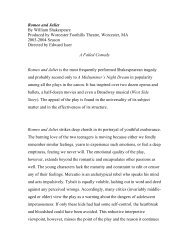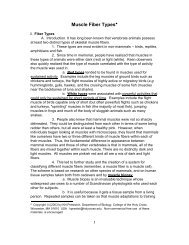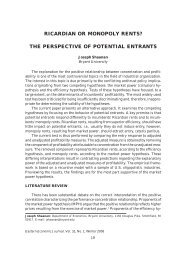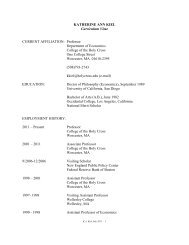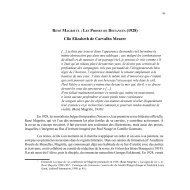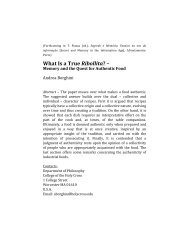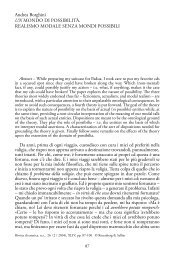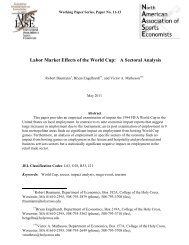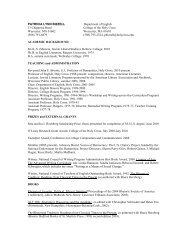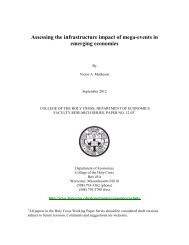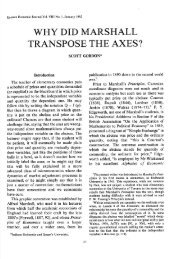29-2 Singh.pmd - College of the Holy Cross
29-2 Singh.pmd - College of the Holy Cross
29-2 Singh.pmd - College of the Holy Cross
You also want an ePaper? Increase the reach of your titles
YUMPU automatically turns print PDFs into web optimized ePapers that Google loves.
CAPITAL ACCOUNT LIBERALIZATION<br />
TABLE 3<br />
Effects <strong>of</strong> Capital Flows and Their Volatility on<br />
Growth per Capita by Decade.<br />
Dependent Variable: Rate <strong>of</strong> GDP Growth per Capita<br />
Independent variable 1970-98 1970-80 1980-89 1990-98<br />
Capital flows 0.287 b 0.149 0.133 0.275 b<br />
Capital flows volatility 0.344 b 0.322 b 0.188 0.124<br />
Initial GDP per capital 0.508 b 0.345 0.940 b 0.159<br />
Initial schooling 1.4<strong>29</strong> 1.749 3.640 a 0.446<br />
Population growth rate 0.513 b 0.438 0.573 b 0.869 b<br />
Investment 0.182 b 0.309 b 0.164 b 0.094 b<br />
Policy 0.008 b 0.007 b 0.011 b 0.013 b<br />
Inflation rate 0.002 b 0.008 -0.001 b 0.004 b<br />
Openness <strong>of</strong> <strong>the</strong><br />
economy 0.001 0.006 0.001 -0.024 b<br />
Adjusted R 2 0.75 0.59 0.57 0.38<br />
No. <strong>of</strong> Countries. 72 56 74 100<br />
a. Significant at <strong>the</strong> 10 percent level<br />
b. Significant at <strong>the</strong> 5 percent level.<br />
Source: World Bank [2001].<br />
203<br />
and pessimism <strong>of</strong> investors largely unrelated to fundamentals. Importantly,<br />
Kindleberger’s historical analysis is implicitly endorsed by Alan Greenspan, <strong>the</strong> Chairman<br />
<strong>of</strong> <strong>the</strong> U.S. Federal Reserve himself, who recently commented on <strong>the</strong> 1987 U.S.<br />
stock market crash and <strong>the</strong> Asian financial meltdown <strong>of</strong> <strong>the</strong> 1990s:<br />
At one point <strong>the</strong> economic system appears stable, <strong>the</strong> next it behaves<br />
as though a dam has reached a breaking point, and water (read, confidence)<br />
evacuates its reservoir. The United States experienced such<br />
a sudden change with <strong>the</strong> decline in stock prices <strong>of</strong> more than 20<br />
percent on October 19, 1987. There is no credible scenario that can<br />
readily explain so abrupt a change in <strong>the</strong> fundamentals <strong>of</strong> long-term<br />
valuation on that one day. ... But why do <strong>the</strong>se events seem to erupt<br />
without some readily evident precursors? Certainly, <strong>the</strong> more extended<br />
<strong>the</strong> risk-taking, or more generally, <strong>the</strong> lower <strong>the</strong> discount factors applied<br />
to future outcomes, <strong>the</strong> more vulnerable are markets to a shock<br />
that abruptly triggers a revision in expectations and sets <strong>of</strong>f a vicious<br />
cycle <strong>of</strong> contraction. ... Episodes <strong>of</strong> vicious cycles cannot easily be forecast,<br />
as our recent experience with Asia has demonstrated. [1998, 4-5]<br />
This mirrors <strong>the</strong> Keynesian view <strong>of</strong> investor behavior and <strong>the</strong> significance <strong>of</strong> mass<br />
psychology in price formation in <strong>the</strong> financial markets, as discussed earlier. Keynes’<br />
insights on this subject have been formalized in current <strong>the</strong>oretical literature, which<br />
is able to provide a “rational” explanation for <strong>the</strong> herdlike behavior, contagion and<br />
o<strong>the</strong>r irrational manifestations <strong>of</strong> economic agents in financial markets [Shiller, 2000;<br />
<strong>Singh</strong> and Weisse, 1999; <strong>Singh</strong>, 1999].



